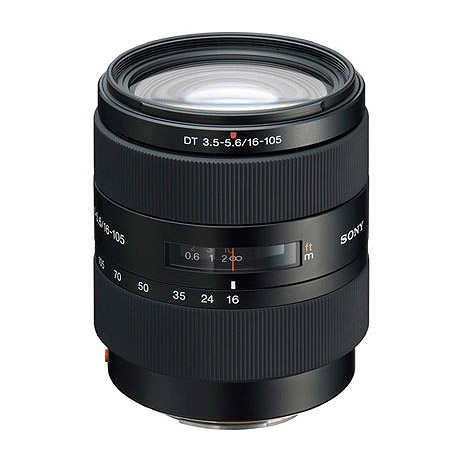Sony DT 16-105mm f/3.5-5.6
 |
Sony's DT 16-105mm f/4.5-5.6 is a general 'walk about' lens that costs around £480 and covers popular focal lengths equivalent to a 24-157.4mm lens on a full-frame camera. Lenses like this tend to be a popular upgrade for those looking for a little more than their typical 18-55mm kit lens offers in terms of focal length. Having a larger zoom range like this also minimises the need to change lenses, preventing dust getting inside the camera.
The closest match from third-party lens manufacturers is Sigma's 17-70mm f/2.8-4 OS, which costs around £330 and adds optical stabilisation to minimise the effects of camera shake and a brighter aperture at the expense of the zoom range.
Sony DT 16-105mm f/3.5-5.6: Handling and features
This optic is quite compact for such a zoom range, but has a reassuring weighty feel to it. The build quality is good with Sony opting for a minimalist finish to the lens. Two finely knurled control rings are provided for zoom and focus control which finish off the look of the lens in a particularly smart way. High quality plastics have been employed in the construction of the lens barrel and a hard wearing metal lens mount has also been fitted to this lens.
Zooming the lens to 105mm almost doubles the length of the lens barrel, which extends in two sections. Focus is performed internally, so the front element does not rotate, making it easy to use filters such as neutral density grads and polarisers. The lens accepts 62mm filters which is a common size and not too expensive to purchase for. Focus is driven via the screw-drive in the camera body so the focus action does make a fair bit of noise during use unlike the newer SSM and SAM driven lenses Sony have begun to offer.
Sony DT 16-105mm f/3.5-5.6: Performance
I would describe the resolution performance of this lens as mixed, as it has its strengths, but also has its weaknesses. At 16mm and f/3.5 the centre resolution is very good, but the corners are a little softer, but still very acceptable. Stopping the lens down improves the resolution towards the edges of the frame with peak performance being achieved at f/5.6, after that the effects of diffraction begin to soften the results, but the lens still performs well down to f/16.
At 50mm the quality towards the edges degrades somewhat, especially at wider apertures, although the centre resolution remains very good. The best quality across the frame is achieved at f/8, where the resolution towards the edges approaches good levels.
Finally at the telephoto end of the range, the lens performs less admirably, but will still be acceptable for many. Peak performance has dropped to f/11, where the resolution in the centre exceeds good levels of sharpness.
Control of colour aberrations is also quite a mixed bag. At 16mm chromatic aberrations just exceed 0.6 pixel widths, which shouldn't pose too many issues in normal picture taking conditions. Zooming to 50mm virtually eliminates any fringing with very low levels of CA being recorded by Imatest. Much higher levels of fringing that will become noticeable in images, especially in high contrast situations were recorded at 105mm.
Fall-off of image illumination towards the corners is well controlled. At 16mm and f/3.5 the corners are only 1.5 stops darker than the image centre. Stopping down to f/5.6 provides even illumination across the frame here. This level of fall-off decreases slightly as the lens is zoomed in, with the corners being only 1.06 stops darker than the centre of the image at 105mm.
Distortion is often the bain of wide-angle zooms and lenses with large zoom ranges. This lens is no exception with 5.99% barrel distortion being recorded by Imatest at 16mm - this lens may pose problems for critical applications that require straight lines coming out as straight lines. Luckily, the distortion pattern is uniform across the frame, so should be easily corrected in image editing software afterwards. Zooming to 105mm trades barrel distortion for pincushion. Here Imatest recorded pincushion of 1.12%, which should cause alarm in normal shooting scenarios.
| Click on the thumbnails for a high resolution image | |
 |  |
| The 16mm wide-angle setting is very useful for capturing wide scenes. | Good sharpness is possible at 105mm when the lens is stopped down. |
This lens can be quite prone to flare, especially at the wide end and with strong point source of light in the frame. I found that under these conditions the lens tends to suffer from a pronounced loss of contrast and brightly coloured flare spots across the frame. A petal shaped lens hood is supplied as standard and I would recommend keeping this on at all times to reduce the chance of flare being caused by light sources just outside of the frame, as the lens is just as susceptible to flare under these conditions.
Sony DT 16-105mm f/3.5-5.6: Verdict
This lens is certainly capable of producing more than satisfactory results if used within its limitations, it just may pay to be fully aware of its shortcomings so you are not disappointed.
The 6.5x zoom range is highly convenient for a 'walkabout', giving a useful wide-angle equivalent of 24mm on a 35mm camera, as well as plenty of telephoto reach.
If the convenience of the zoom range is what you're after, this lens may be worth a look, whereas if you're upgrading from your kit lens purely to improve the quality of you images, it may be worth looking towards a lens with a less ambitious zoom range.
Sony DT 16-105mm f/3.5-5.6: Pros
 Useful zoom range
Useful zoom range Good build quality
Good build quality Good centre resolution at the shorter end of the zoom range
Good centre resolution at the shorter end of the zoom rangeSony DT 16-105mm f/3.5-5.6: Cons
 Resolution towards edges of the frame from 50mm onwards
Resolution towards edges of the frame from 50mm onwards Barrel distortion at 16mm
Barrel distortion at 16mm Prone to flare
Prone to flare| FEATURES |  |
| HANDLING |  |
| PERFORMANCE |  |
| VALUE |  |
| OVERALL |  |
Sony DT 16-105mm f/3.5-5.6: Lens specification
| Price | £479 |
| Contact | www.sony.co.uk |
| Filter size | 62mm |
| Format | APS-C |
| Construction | 15 elements in 11 groups |
| Angle-of-view | 83-15 degrees |
| 35mm equivalent focal length (on APS-C body) | 24-157.4cm |
| Internal focusing | Yes |
| Image stabilisation | No |
| Minimum focus | 40cm |
| Maximum aperture | 3.5-5.6 |
| Minimum aperture | f/22-36 |
| Weight | 470g |
| Size | 83x72mm |
| In the box | Petal-shaped lens hood |
The Sony DT 16-105mm F/3.5-5.6 costs around £480 and is available from Warehouse Express here:
Sony DT 16-105mm F/3.5-5.6
Add your message
Login required
Please login here or if you've not registered, you can register here. Registering is safe, quick and free.
Please login here or if you've not registered, you can register here. Registering is safe, quick and free.
photodo Stats
1102 lenses
428 MTF tests
74 in-depth photodo reviews
100+ users join each day
Help the lens community by reviewing or rating a lens today via our lens search
428 MTF tests
74 in-depth photodo reviews
100+ users join each day
Help the lens community by reviewing or rating a lens today via our lens search
Latest Lens Reviews
- Chinon 28mm f/2.8 Vintage Lens Review
- Canon EF 70-200mm f/4L IS II USM Lens Review
- Samyang AF 85mm f/1.4 EF Review
- Sigma 70mm f/2.8 DG Macro Art Review
- Samyang AF 24mm f/2.8 FE Review
- Meike 50mm f/1.7 Review
- Tamron 70-210mm f/4 Di VC USD Review
- Lensbaby Burnside 35mm f/2.8 Review
- Asahi Super Takumar 50mm f/1.4 Review
- Asahi Super-Multi-Coated Takumar 135mm f/3.5 Review






